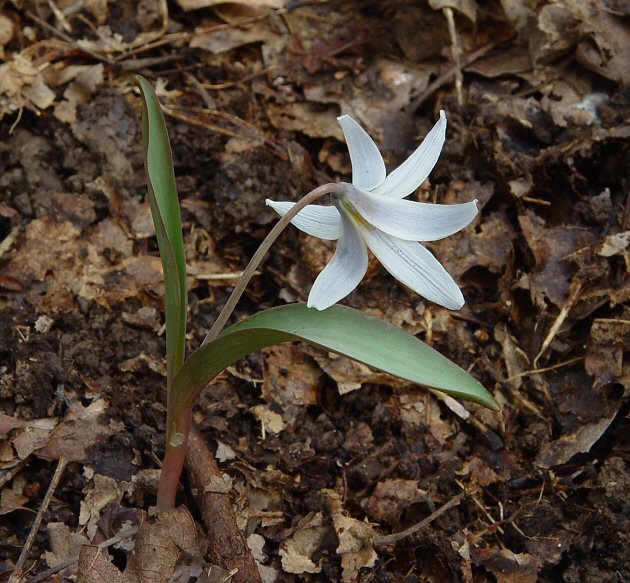Erythronium albidum Nutt.
White Dogtooth Violet

Native
CC = 5
CW = 3
MOC = 77
© DETenaglia
Erythronium albidum Nutt.White Dogtooth Violet | |
 |
Native CC = 5 CW = 3 MOC = 77 |
© DETenaglia |
|
Family - Liliaceae Habit - Perennial forb with deep-seated, bulblike corms, lacking the odor of onion or garlic. Stems - Ascending to erect, to 20 cm, unbranched, glabrous. Leaves - Alternate or subopposite, appearing basal, two per flowering plant, one in nonflowering plants, the bases tapering into a sheath. Blades to 20 cm long, 1.3-4.0 cm wide, lanceolate to narrowly ovate or elliptic, flat, glabrous, green and glaucous on the undersurface, usually somewhat mottled with brown.
Inflorescence - Single nodding flower terminating aerial stem. Flower - Perianth 15-50 mm long, strongly reflexed, white, sometimes slightly tinged with pink, the sepals and petals free, lanceolate. Stamens 6, free, exserted. Anthers yellow, 6mm long. Style 1, somewhat thickened near the tip, the stigmas 3,2-3 mm long, slender, spreading to recurved. Ovary superior, with 3 locules, each with 8-20 ovules.
Fruits - Capsules, weakly 3-angled, 10-25 mm long, obovate, the tips rounded. Stems remain ascending in fruit, holding the fruit off the ground.
Flowering - March - May. Habitat - Mesic and bottomland forests, often in alluvial soils. Origin - Native to the U.S. Lookalikes - E. mesochoreum. Other info. - This is a favorite springtime ephemeral wildflower which is common in rich wooded areas throughout Missouri. Outside of Missouri its range includes the Midwest and extends into New England and Canada. It is reasonably easily recognized by general appearance, with a single nodding flower on a stem arising from between two mottled leaves. Main differences from its lookalike E. mesochoreum include a flower with reflexed tepals, a more colonial habit, and fruits held off the ground instead of prostrate. Leaf mottling is somewhat variable. Photographs taken at Reform Conservation Area, Callaway County, MO., 3-24-04 (DETenaglia); also at Washington State Park, Washington County, MO, 4-5-2010 and 4-15-2019, Weldon Spring Conservation Area, St. Charles County, MO, 4-17-2014, Glassberg Conservation Area, Jefferson County, MO, 4-4-2016, Young Conservation Area, Jefferson County, MO, 3-27-2021, and Canaan Conservation Area, Gasconade County, MO, 4-26-2021 (SRTurner). |